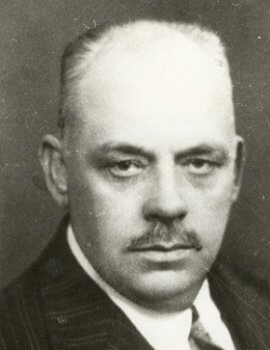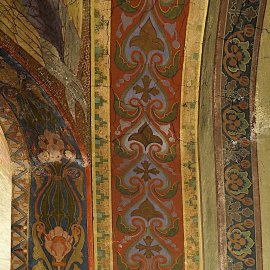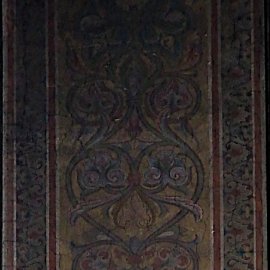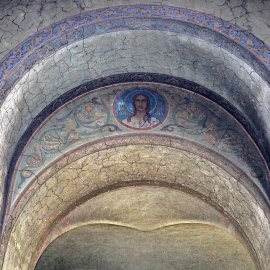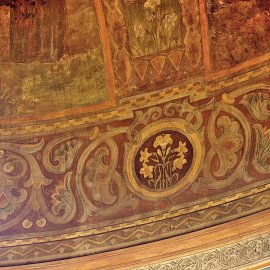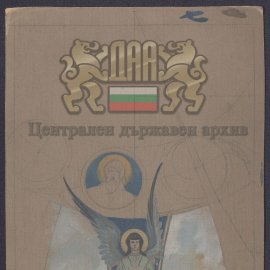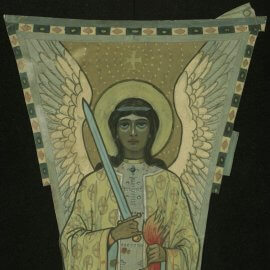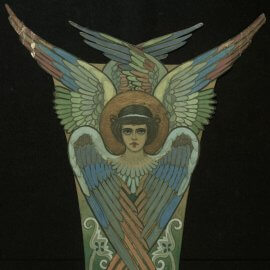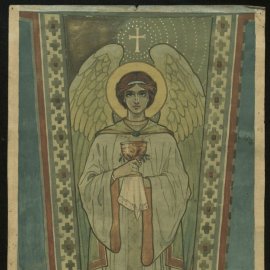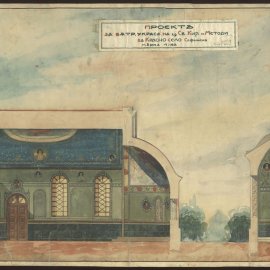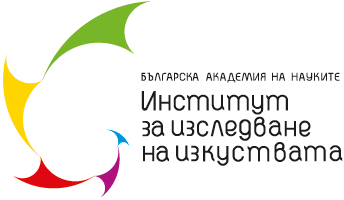Basic information
Born: 19 July 1875 (Plovdiv)
Died: 13-14 April 1941 (Sofia)
Art education
1896–1899 - a general course at the State Art School (under Ivan Mrkvička);
1900–1905 - a specialized course in Decorative Art at the State Art School (under Raymond Ulrich);
Painting in the churches of Sofia
- 1911 – Church of St. Nicholas of Sofia the New – murals (ornamental decoration);
- 1912 – St. Alexander Nevsky Cathedral – ornaments in the south part of the church;
- 1925 – Church of The Ascencion of Christ – designs for the ornamental decoration в the naos;
- 1926 – Church of Sts. Heptarithmoi – a design for a frieze in the dome;;
- 1930 – Church of the Saints Cyril and Methodius, Krasno Selo district – a design for murals.;
State of research
Haralampi Tachev’s work is extremely diverse and its different aspects have been studied by a number of authors, mainly in relation to his activity associated with the Contemporary Art Society1Miteva 1997: 121-182; Georgieva 2001: 166-185; Georgieva 2002; Georgieva 2004; Georgieva 2012: 20-37; Georgieva 2016: 64-74., the authorship of the coat of arms of Sofia2Georgieva 2002a: 54-61; Georgieva 2005: 114-125; Gadzhev 2005: 40-41; Nikolov 2008: 31., his ceramics projects3Miteva 2008: 27-31; Vasilchina 2010: 124-130., his teaching work4Bozhkov 1962; Minekov, Rusev, Bozhkov, Domuschiev, Chukovski 1984., his participation in international exhibitions5Georgieva 1999: 32-42.. However, his church art works remains outside the interest of researchers and is only mentioned in relation to his participation in the mural decoration of some churches6Belkovski 1957: 6; Karavelov 1966: 206; Kalev 1979: 92; Paskaleva 1986: 6; Radkova 1999: 88. without specifying his individual work.
Biography
Haralampi Tachev was born on 19 July 1875 in the city of Plovdiv7Entsiklopediya 1987: 72.. He was admitted to the first course of the State Art School in 18968Bozhkov 1962: 23; Minekov, Rusev, Bozhkov, Domuschiev, Chuhovski 1984: 26. and studied under Ivan Mrkvička9Marinska 1996: 118. who had taught him at his high school in Plovdiv. In 1900, he completed the general course of the State Art School and continued to specialize in Decorative Art10Miteva 1997: 125., under the Austrian Raymond Ulrich. It is known that among the first teachers of Tachev there were ones from Austria-Hungary and Czechia: Josef Sylaba, Josef Pitte. Together with Ulrich they promoted the ideas of the new style of the Secession11Georgieva 2016: 65. . In 1905, Tachev completed the special course in decoration. In 1910, he started to teach at the School of Art and Industry12Minekov, Rusev, Bozhkov, Domuschiev, Chuhovski 1984: 30, 31. .
Haralampi Tachev is one of the founders of the Contemporary Art Society13Georgieva 2001: 169. as the idea of that society was born during a meeting of the artist and architect Pencho Koychev who was restoring the mausoleum in Pleven at the time. It became clear that the project would require painters for the icons, decorators for the interior, carvers for the iconostasis, etc. The idea of bringing together various kinds of artists to perform joint projects was thus born14Georgieva 2001: 169. . One of the fundamental objectives set by the members of the Contemporary Art Society was to realize in practice of the synthesis of plastic arts and architecture15Kirov 1976: 33. .
During his entire active artistic career Tachev engaged in church art. There is data that Haralampi Tachev worked projects for painting of a number of churches all over the country: the Saints Cyril and Methodius in Plovdiv16CDA, f. 2005к, inv. 1, а.u. 1318, p. 1-2., St. George in Belozem17CDA, f. 2005к, inv. 1, а.u. 782, p. 1-9. , the church of the Assumption in Ruse18Mutafov 2019: 43; Popov 1937: 2; Manchev 1937: 2; CDA, f. 2005к, inv. 1, а.u. 784а, p. 10, 11, 23., St. John the Forerunner in Kazanlak19CDA, f. 2005к, inv. 1, а.u. 784, p. 1,3, 7-13, 16, 17. , St. Marina in Plovdiv20CDA, f. 2005к, inv. 1, а.u. 780, p. 1-27; CDA, f. 2005к, inv. 1, а.u. 1218, p. 1-30., St. Nicholas in Karlovo21CDA, f. 2005к, inv. 1, а.u. 781, p. 1., St. George in Plovdiv22CDA, f. 2005к, inv. 1, а.u. 775, p. 1-4., St. John of Rila in the villae of Bichkinliya, District of Gabrovo23CDA, f. 2005к, inv. 1, a.u. 1251; CDA, f. 2005к, inv. 2, а.u. 115, p. 1- 4. The design of the interior decorative painting of the church was elaborated by Haralampy Tachev, Stefan Ivanov and Tsanko Vasilev, see CDA, f. 2005К, inv. 1, a.u. 788, p. 1-8., All Saints in Ruse24CDA, f. 2005к, inv. 1, а.u. 794, p. 1-2., the Holy Trinity, Svishtov25CDA, f. 2005к, inv. 1, а.u. 1289, p. 1,2; CDA, f. 2005к, inv. 2, а.u.119, p. 1-4. and others. In 1938, the artist had correspondence regarding the painting of the Church of the Holy Trinity in Kozloduy26CDA, f. 2005к, inv. 1, а.u. 789, p. 1-8. , and in 1939 for the Church of the Assumption, Varna27CDA, f. 2005к, inv. 1, а.u. 784а, p. 1-7., as subsequently the work in both churches was not carried out.
Tachev engaged not only in church painting but also in a number of other activities related to church art. In 1904–1905, he accepted a commission to prepare “drawings” for halos for the church of St. Nedelia (Kyriake) in Sofia28CDA, f. 2005к, inv. 1, а.u. 743, p. 1, 2. which were not carried out subsequently. He participated in commissions for acceptance of copies of Medieval murals29In 1911, in accordance with Instruction No. 8338, Ordinance No. 1102 of the Ministry of Education Haralampy Tachev was included in a committee for evaluation and approval of the frescoes in the church of St. 40 Martyrs in Veliko Tarnovo copied by M. Georgiev, see CDA, f. 2005К, inv. 1, a.u. 231, p. 1.. In 1912, he made the models of the candlesticks in front of the soleas of the Church of St. Nicholas of Sofia the New30Temelski 2019: 117. . In 1923, together with Dimitar Gyudzhenov Haralampi Tachev was appointed by the head of the State Academy of Art as member of a commission for the acceptance of the painting works (icons and decoration) made by the artist Apostol Hristov for the Church of St. Paraskeva31CDA, f. 2005к, inv. 1, а.u. 240, p. 1, 2. . Tachev made church woodcarving designs for the Church of The Ascencion of Christ which was commissioned to Iliya Ognyanov in November 192532Haralampy Tachev was invited by the chair of the temple’s Church Council to present the projects and review the work performed by Ognyanov, see CDA, f. 2005К, inv. 1, а.u. 761, p. 1. . In 1940, Dragovitia Bishop Chariton, rector of the Ecclesiastical Seminary of Sofia, commissioned the artist to make a drawing to serve as a model for the mosaic of the church at the Cherepish Monastery which was under construction at the time33CDA, f. 2005к, inv. 1, а.u. 798, p. 1.. In Tachev’s archive there are designs for candlesticks, chalices, chandeliers, analogion34CDA, f. 2005 к, inv. 2, а.u. 133, л. 15. , church cathedra, royal doors, drawings and sketches of saints and angels and ornaments for the interior decoration of churches35CDA, f. 2005 к, inv. 2, а.u. 128, p. 1-15. . The artist created a design for the decoration of the cover of the Memorial Book of St. Alexander Nevsky Cathedral36CDA, f. 2005к, inv. 2, а.u. 123, p. 1. .
Painting in the churches of Sofia
The first church work of Tachev in the capital was the murals in the Church of St. Nicholas of Sofia the New in 191137Temelski 2000: 116; CDA, f. 2005к, inv. 1, а. u. 754, p. 2.. He worked jointly with Gospodin Zhelyazkov, Stefan Ivanov, Nikola Petrov and Apostol Hristov. There is information about the overall outlook of the initial artistic decoration of the church38The temple’s narthex was painted with compositions (seven in number), the central dome was painted with depictions of Jesus Christ and the Apostles; the apse was also painted, see Svedenia 1951.. According to H. Temelski Haralampi Tachev made the ornamental decoration39Temelski 2000: 116.. Some archival photographs of the installation of the iconostasis in the church show some details of that ornamental decoration. A freize of medallions with crosses painted inside them ran in the apsis, underneath the scene of the Annunciation. A complex composition of stylized colorful motifs and creepers in the spirit of Secession was formed in the pediment above the three apsis windows. An ornamental frieze of stylized colors with crosses integrated inside it was elaborated in the thickness of the arches. By analogy one can assume that all structural elements were given the same treatment in order to outline the architectonics of the church. The depicted compositions were also framed with an ornamental frieze.
In 1936, the church’s board of trustees took steps to “restore the interior decoration” which had suffered earthquakes, atmosphere impact and the subsequent repair of the roof40It is explicitly mentioned that the interior decoration of the temple excluding the icons is in need of restoration, see CDA, f. 200К, inv. 1, a.u. 785, p. 2.. The letters of Haralampi Tachev to protoiereus Vasiliy, Chair of the board of trustees of the church of St. Nicholas of Sofia, show that the collective which Tachev was also a member of41The letter does not mention the names of all the painters who would participate in the restoration. would carry out restoration and additional decoration works42The work is separated on ‘oil-based paint and decorative’, see CDA, f. 200К, inv. 1, a.u. 785, p. 4.. It was stipulated the walls in the interior to be cleaned, the ornamental decoration to be repaired, the walls to be repainted in “more vivid” colors in order to resemble red marble/onyx, the pilasters and the socle to imitate dark green marble, the depictions of the saints on the entrances to be restored and refreshed.
Probably that restoration of the interior of the church was not carried out because it is known that in 1954 the church’s board of trustees addressed a request to Apostol Hristov to restore the damaged painting, an agreement was reached but subsequently the deal was broken43Temelski 2019: 144. . In 1966, the interior of the church was painted again by a collective composed of the painters Nikolay Rostovtsev, Karl Yordanov, Gospodin Georgiev and Georgi Belstoynev as some of the old murals were cleaned from dirt and restored44 These were: Christ Pantocrator in the central dome, St. John of Rila above the southern entrance, the compositions of St. Heptarithmoi and the Venerable Gabriel of Lesnovo, Prohor of Pčinja and Joachim of Osogovo on the western wall, St. Euthymius, Patriarch of Tarnovo and St. Theodosius of Tarnovo on the wall next to the entrance, the two angels on the western wall, the angel above the western door and the angels on the arch of the balcony with medallions of prophets, see Temelski 2019: 145..
The ornamental decoration of St. Alexander Nevsky Cathedral was made by Boris Mihaylov, Nihail Sudovski, Vasiliy Perminov and Haralampi Tachev45Karavelov 1966: 157, 158.. Boris Mihaylov had the biggest share in the works46Karavelov 1966: 206. For St. Alexander Nevsky Cathedral B. Mihaylov made the text of the Lord’s Prayer and the ornaments on the drum of the dome as well as four texts on the obverse of the arches of the main supporting columns, the ornaments on the obverse of the north arch-shaped niche with a triple window, the mosaic imitations in the domes of the galleries, next to the entrance doors and the passages to the side naves, the ornaments on the arches of the stairs to the matroneum and others. See Radkova 1999: 88. as Haralampi Tachev’s work was second in terms of importance and volume47Karavelov 1966: 206.. On 7 March 1912, the building committee signed a contract with Haralampi Tachev and commissioned him to make ornaments in the southern part of the churcn within four months48Karavelov 1966: 157..
For the obverse of the southern arched niche with the triple window Haralampi Tachev developed two types of ornaments. One is big and quite richly developed, curved into the thick of the blind arch as it is framed with a second one of smaller size. In the thickness of the arches separating the naos from the southern nave a total of six different ornamental friezes are elaborated. Tachev’s work was accepted in July and he was paid a fee of 5970 Bulgarian leva for it49Karavelov 1966: 157.. The decorative elements and chuch symbols in the top part of the walls of the southern gallery were made by Boris Mihaylov50Karavelov 1966: 158.. A major part of them are also repeated in the northern gallery. Karavelov provides information that Tachev also painted crescent-shaped tympans, a work commissioned to him in March 1913 for which he earned a fee of 150 Bulgarian leva51Karavelov 1966: 158.. These are the three pediments formed above the arches that divide the naos from the southern gallery. In each pediment Tachev made a mirror secession ornament elaborated along the two sides of a medallion with a depiction of a saint52From west to east are depicted: St. Catherine, St. Stephen, St. Agapius.. Unfortunately, this piece of painting is currently in a very bad condition. But judging by the description provided by L. Karavelov it becomes clear that the depictions of the saints were made by Tachev.
After the Liberation, the Church of The Ascencion of Christ was rebuilt. The church was not painted until in 1925, probably due to the lack of funds. Apostol Hristov, jointly with Haralampi Tachev created the murals in the naos of the church53Софийската 1994: 6; ЦДА, ф. 2005к, оп. 1, а.е. 761, 3-10.. The commissioned work was made after a bidding procedure specifying the requirements for the contractors54“The entire interior of the church at a height of four meters must be decorated with ornamental compositions in a “strict church style” in a combination, where the place so requires, with various symbols, accessories, texts, and others. All vaults must be painted in dark azure blue dye and decorated with stars and ornaments. The places intended for figural compositions (the apsis, the pendentives) must not be decorated; they must only be framed. The windows had to be framed in the same manner. All columns and pilasters in the narthex must imitate porphyry. The capitals of the big columns and the small ones in the matroneum as well as the pilasters must imitate bronze with accented points.”. On 15 July 1925, a contract was entered into between the two contractors for the performance of the decorative ornaments of the church (without the icon painting works). According to the terms of reference Haralampi Tachev prepared designs for the ornamental decoration in the naos of the church to a scale of 1:10 in paint, and also did the same in real-life dimensions in contour. Apostol Hristov was in charge of the performance of the projects55CDA, f. 2005к, inv. 1, а. u. 761, p. 10.. Unfortunately, there is no information about the look of the murals.
The dome of the Church of Sts. Heptarithmoi was painted in 1926. Stefan Badzhov was the author of the design and led the icon painting work. The thesis accepted in the literature is that the ornamental decoration was made by Haralampi Tachev56Kalev 1979: 92.. However, some researchers such as Vera Dinova-Ruseva and Maria Miteva have suggested that the ornamental decoration of the dome was made precisely by Stefan Badzhov57Dinova-Ruseva 1996: 15; Miteva 2014: 106..
It is known that Haralampi Tachev was among the initial collective in charge of the painting of the church58On 5 December 1925, a contract was entered into among the painters Stefan Badzhov, Haralampi Tachev, Dimitar Gyudzhenov, Nikola Marinov and Gospodin Zhelyazkov for the performance of the decorative ornaments of the churches of Sts. Heptarithmoi and of the Saints Cyril and Methodius in Sofia. see CDA, f. 2005К, inv.1, a.u. 755, p.7,8.Zhelyazkov concluded a contract for the painting of artistic decoration of the Sofia churches of Sts. Heptarithmoi and Sts. Cyril and Methodius, see CDA, f. 2005К, inv.1, a.u. 755, p.7,8.. The correspondence between the board of trustees of the Church of Sts. Heptarithmoi and Haralampi Tachev makes it clear that his obligation was to deliver sketches to a scale of 1:10 by 1 August 1926, which was not carried out in time by the artist59CDA, f. 2005к, inv. 1, а.u. 755, p. 10.. At a meeting of the co-parties to the contract (Stefan Badzhov, Haralampi Tachev, Dimitar Gyudzhenov, Nikola Marinov and Gospodin Zhelyazkov) held on 23 December 1926 it was resoved to dismiss Tachev from the work on the murals on the dome of the Church of Sts. Heptarithmoi because of his failure to fulfill his duties. The same document makes clear that the artist was obliged to paint the images of four of the angels and others but had only delivered the frieze underneath the angels’ figures by then60CDA, f. 2005к, inv. 1, а.u. 755, p. 9. . It seems that there was a conflict between Haralampi Tachev and Stefan Badzhov because on 16 September 1927 Tachev sent Badzhov a notarized notice by which he demanded to get a detailed bill of the expenses incurred and the revenues receive under the commission in order to know the actual amount of his rights under it. With this document Tachev notified Badzhov that if the requested information was not received within the specified term, he would file a fraud case61CDA, f. 2005к, inv. 1, а.u. 755, p. 19..
All of this shows that Tachev made only one frieze design for the dome of the Church of the Seven Saints. The frieze is an ornamental, interlacing one that runs underneath the angels’ figures and frames the windows, it was functionally used as a frame separating the individual images but also as a supplementing element of the entire image: a work of stand-alone artistic value. In the archive of the artist there is one preserved preparatory drawing depicting an angel with an ornamental frieze underneath him which very closely resembles the one made in the dome62CDA, f. 2005к, inv. 1, а.u. 802, p. 1., which proves with certainty the authorship of that element of the mural decoration of the church. In some motifs used in the frieze (the top and bottom parts) the influence of the ornaments of the Old Bulgarian manuscripts is clear but the true floral ornament is inspired by the Secession. This combination of old Bulgarian motifs and contemporary European influences is a modernization of the overall traditional church ornamental system in accord with the then current tendencies that can be observed in the secular painting from the period.
In the archive of the artist are preserved the preparatory drawings depicting the seven archangels he planned for the dome63CDA, f. 2005к, inv. 1, а.u. 1115, p. 1-7.. The question of why those drawings were not delivered in time remains open. After the breakup of the relations between Badzhov and Tachev the archangels were depicted on the basis of a design by Stefan Badzhov.
In 1930, Haralampi Tachev sent a letter to the board of trustees of the Church of the Saints Cyril and Methodius, Krasno Selo district, with an enclosed design for painting of the church64CDA, f. 2005к, inv. 1, а.u. 773, p. 1; CDA, f. 2005к, inv. 1, а.u. 1009, p. 1.. The sketches are to a scale of 1:40, they were made with water color and pencil. The letter makes clear that the entire decoration would be made in “our strict church style.” Cherubim, symbols, and others would be painted at certain places (as per the design). All frames around the spaces where images were to be depicted, the frames of the windows, doors and the thickness of the masonry would be decorated by a “gorgeous” ornament. A frieze would be made around the image of Christ and the on the frame surrounding the vault as well as around the medallions of the four Evangelists and the Apostles. Underneath the image of Panagia Orans it was planned to make yet another frieze. On the vault, underneath the image of Christ a large ornamental cross had to be made with round spaces in its four ends for the images of the four Evangelists. The text of the Lord’s Prayers had to be painted inside the frame around Christ. A plaster cornice that might be decorated had to be placed on the line between the vault and the vertical walls65CDA, f. 2005к, inv. 1, а.u. 773, p. 1..
The only study of the church states that it was fully painted by the brothers Dechko Mandov and Radomir Mandov in 1930–193266 NINKN, С-997-10, 4. The research of the church was made by Rositsa Achkova in 1987.. When Tachev’s design is compared to the mural decoration made on situ in the church it is notable that there are a lot of similarities between the artist’s idea and the murals made. Although they are smaller in size the standing figures of the saints are painted in between the window openings. The solution of the arch in front of the apsis with the round medallions with depictions of saints is quite similar. Similarly to the design, Panagia Orans is painted in the zenith of the apsis, and on the vault there is a medallion with a depiction of Christ Pantocrator67This depiction has been overpainted. The information about it comes from an archive photograph kept at National Documental Archive of NINKN. See: NINKN, С-997-10, 1. The fact that in 1983–1984 the mural decoration was overpainted by Veselin Panaveev must be taken into consideration68NINKN, С-997-10, p. 4. because it presumes certain replacement of the authentic look of the painting. At that time the medallion depicting the Pantocrator on the vault of the church was painted over.
At this point it should be noted that on 27 March 1925 a contract of mutual understanding and concurrence of the interests (an “alliance”) related to the performance of artistic and decoration works was entered into among Haralampi Tachev, Apostol Hristov and Dechko Mandov. The contract’s term was five years and it clarified their rights and obligations in their joint work69The contract states specifically that no member of the union may enter agreements with other painters regarding undertakings of the abovementioned type without the consent of the others. See: CDA, f. 2005К, inv. 1, a.u. 760, p. 1, 2.. It is notable that the contract was entered into before the commencement of the work on the murals of the Church of The Ascencion of Christ where the three co-parties worked and was in force while the Church of the Saints Cyril and Methodius was painted. Based on all of this it may be suggested that the original mural decoration of the church in Krasno Selo district was made based precisely on Haralampi Tachev’s design. The conceptual design for the painting work is preserved in the archive of the artist70CDA, f. 2005к, inv. 1, а.u. 1009, p. 1..
Haralampi Tachev is one of the few artists from the second post-Liberation generation and Contemporary Art Society who did church painting. One of the lines which the newly established society was opposed to the old Society for Support for the Art in Bulgaria, renamed in 1893 “Society of Artists in Bulgaria,” is church commissions71Protich 1953: 42.. However, with respect to the church painting the conflict between the artists from two societies is not only on a coterie basis, a thesis that has been stated by some researchers72Kirov 1976: 39., but is also based on the new aesthetics that the “young” attempted to impose in different kinds and genres of art, even in the conservative art such as church mural and icon painting. Haralampi Tachev’s ornament is a return to traditions by way of the possibilities offered by the Modernity of the Secession. The desire to Bulgarize the Secession by seeking for and adapting what is national which had been understood as ethnography by the realist academicians such as Mrkvička and Mitov, is among the fundamental tenets of the By-laws of Contemporary Society, co-founded by Tachev. Haralampi Tachev is one of the first artists who started to pave the way for the Secession in church mural painting which is a remarkable moment in the renovation of religious painting which had been strictly subjugated to the academism until then.
Vesselina Yontcheva

